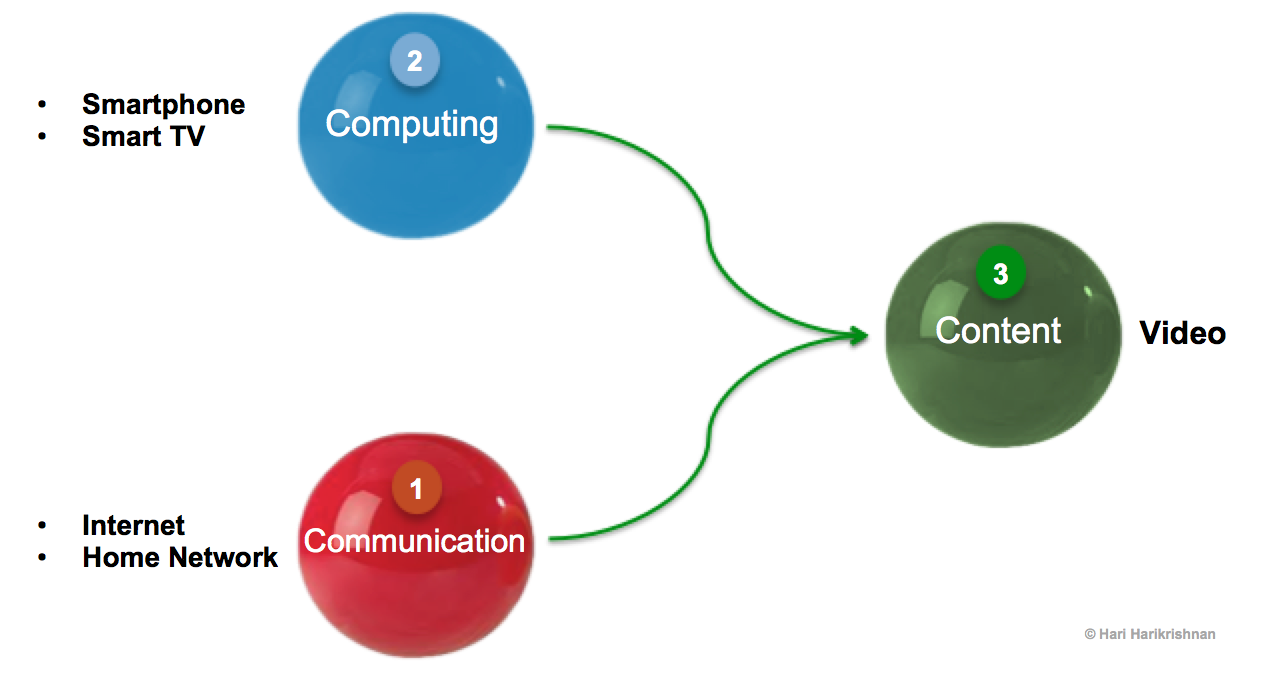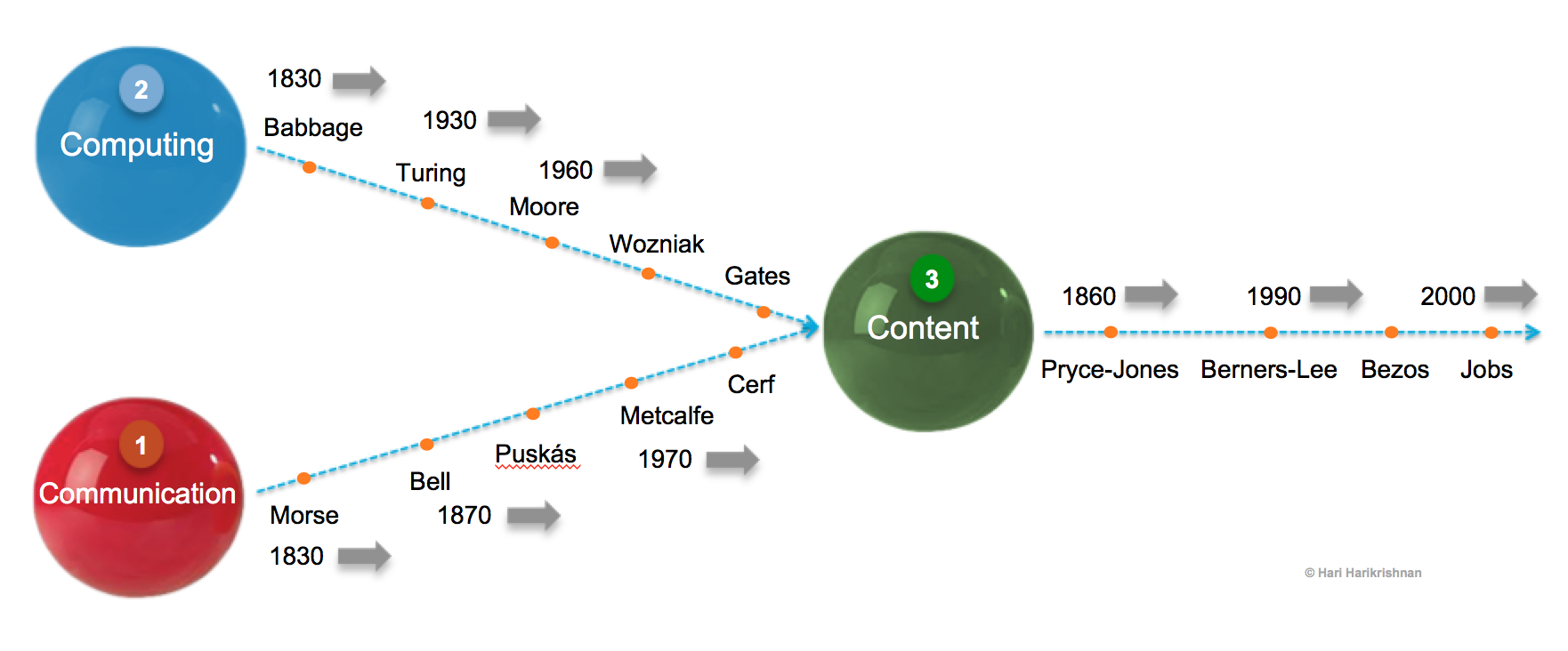It’s a Friday night. I am perched on a cozy corner of my couch, wine on one hand, my smartphone on the other. The smart TV is on. I am pulling up House of Cards on Netflix via the phone, projecting it to the TV via Google Chromecast. Life is good! And then I start to ponder on how I came to be using computers from my couch to entertain myself; on how we arrived at Couch Computing.
Cloud to Couch
How did we get here? And that too, in a seemingly short time? Cloud aficionados will say it is all due to the cloud. Smartphone fans will attribute all this convenience to these versatile handhelds. There is truth in both, but there is more. It is a journey through time on multiple technology trends, computing technologies and telecommunication technologies being the primary ones. How they have been mashed together to deliver content in various forms resulted in my couch computing. A superficial look at the 3 Cs of Couch Computing that combined to deliver my entertainment is shown below.

History of Couch Computing
Let’s get past the superficial and dig for more history on how we got here. The picture below shows the historical evolution of couch computing over the last two centuries on 3 axes — communications, computing, and content delivery. Each axis depicts eras and names of inventors, influencers, or the main protagonists of the technologies or business models.

A quick look at some of those names by axis:
- Communications Axis: Samuel Morse and Alexander Graham Bell, known as Fathers of Telegraph and Telephone respectively (though controversially); Tivadar Puskás who invented telephone exchanges and set in motion a century of automation and widespread rollout of telephones. Robert Metcalfe et al who contributed to local area networks (LAN) via ethernet invention. Vinton Cerf et al who contributed TCP/IP that powers the Internet
- Computing Axis: Charles Babbage (“Father of Computers”) and Alan Turing, pioneers in computing machines; Gordon Moore and his contemporaries who contributed integrated circuits, microprocessors, and Moore’s law to the evolution along this axis.
- Content Axis: Sir Pryce Pryce-Jones who started the mail order business (built on catalogues, postal system, and rail transport system) which was later accelerated by telephones and internet; Tim Berners-Lee who invented the web and super-charged digital content delivery; Jeff Bezos of Amazon whose business can be oversimplified as a reinvention of Pryce-Jones’ business model using Bernes-Lee’s technology. Steve Jobs who in his second coming (after the Wozniak-Jobs duo of the 1970s) combined the 3C’s effectively and innovatively in his computing and communications machines.
Looking at some of the axes together reveals how some of them served to reinforce another axis. For example, while human communications had evolved from semaphores and hand-signs from ancient ages with telegraph, we would be dependent on electrical or mechanical systems still if it were not for automation via electronics and computers. Similarly, without the powerful combination of communications and computing, content delivery would have depended on postal mail and transportation networks. Think of the quantum jump from Pryce-Jones to Bezos era and how technology transformed the old mail order business.
While I have intentionally (and perhaps arbitrarily) picked certain names from the past to name the milestones in this journey, they are by no means the only ones that contributed to this. For example, Alexander Graham Bell is known as the father of telephone. However, this article shows how inventor assignment can be tricky as in the case of Bell and contemporary inventors like Antonio Meucci and Elisha Gray. The same goes for Morse and Alfred Vail when it comes to telegraph. By no means are these the only ones responsible for these technologies. Think of the names against the dots simply as proxies for the brilliant minds who contributed to these axes.
Modern Day: Mixing up the 3 Cs
All that history is mind-boggling. But let’s look at more proximate developments in the last 50 years and see how we have evolved these technologies individually and collectively.

We can write many long stories about each axis, and longer ones on their dependence to each other. Since that would be uncharacteristic for a dummy’s guide, here are some highlights and observations on how innovation in one axis accelerated the innovation in another axis:
- Communications Axis: Early days of internet saw us adding data communications on top of a telephone network (“dial-up internet services like AOL”). Then we converted the underlying network to a data-centric network (“broadband internet”). Then we sent telephone calls over it, thanks to digitized voice. Then came mobile voice networks and mobile data technologies (4G, LTE etc.).
- Computing Axis: Every step in the transition depicted on this axis is directly influenced by a transition in the communications axis. The age of large main computers (“mainframe”) with directly connected users via terminals (“green or orange screens”) was replaced with minicomputers and personal computers that were interconnected (“client-server”) via local area networks. The next era of saw long-distance data communications in the form of broadband internet give rise to centralized high-density large-scale computing (“cloud computing”) accessed over the internet. Coupling this with the next innovation on the communications axis gave us the current incarnation of client-server computing (“cloud-mobile”).
- Content Axis: On-demand video that gave me my charmed couch life is made possible by marrying computing, home networks (LAN), and broadband communications (cable TV originally and now Internet TV). Now we can get all kinds of content – virtual, physical, perishable – delivered more quickly and reliably than in the days of Sir Pryce-Jones by using axis 1 and 2, the delivery of physical goods controlled by computers and communications. Technically speaking, axes 1 and 2 act as “control plane” directing the flow of goods, much like postal network or telephone did for mail order.
Content to Contentment
We live in an era where quick delivery of most virtual content is possible. Physical content deliverers are expanding their menu of offering to perishables (“potatoes direct to your couch”). Uber can get cars dispatched at our pleasure. So we have the 3Cs acting together powerfully to deliver a fourth – contentment. Assuming that computing and communications technologies continue to improve, what holds in store for the content axis? Drone-based delivery of goods for increased instant gratification for sure. What other aspects of human contentment can we improve? What other technology axes not covered here are we dependent on for furthering our satiation?

Here is the gear for couch computing https://www.kickstarter.com/projects/858774620/endlich-schmerzfrei-mit-dem-notebook-von-zu-hause?ref=user_menu